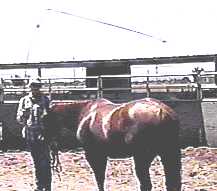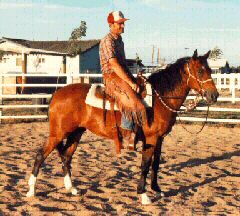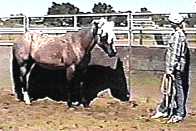"Open Training" and setting up
|

|
|
A horse is a large emotional animal with four feet. If you want those four feet to work well for you (e.g., take you where you want to go without a struggle), you not only have to train and condition the horse's body, but get his emotions under control. It has been said by many experts that a horse is "thinking what he is feeling." This makes sense as he is a prey animal and when the predators arrive for lunch he needs to be able to immediately "feel" fear which triggers the response to get the heck out of there. The "last horse out" was a meal. It didn't take too many generations of horses for this "flee or become dinner" instinct to become hereditary. This basic instinct which serves the feral horse so well in the wild can actually be a hinderance in the human environment. They don't need to fear being eaten, at least not around the barn, and their ability to immediately react in our complicated world can get them, or the humans nearby, seriously hurt. As a result, we have focused our training approaches on getting the "emotional horse inside" under control first. Once this is done, the training which follows, if you'll pardon the metaphor, is a piece of cake.
We call this training format "open training." It is very similar to "resistance free training", the primary difference is we focus a bit more intently on developing the horse's decision making skills. You see, we don't want to dull or depress the horse's senses. We need them so that the horse will learn quickly and will perform well. We simply intend to harness these emotions and channel them into more productive, and less disruptive, avenues. We accomplish this objective in several ways. First of all, we treat all horses with respect. They all seem to have the capacity to learn rather quickly if we don't try to intimidate or abuse them. We don't want the horse wasting our time and his energy being "defensive" in response to our inappropriate behavior. We simply understand how a horse perceives respect; we give it, and we also demand it, right from the start. Horses naturally understand this concept. We establish ourselves as the "herd leader" using approaches which the horse instinctively relates to. With a frightened or feral horse, we will "approach and retreat," emulating the inquiries of another "stranger" horse. Once the horse is reasonably relaxed (we're usually talking a few minutes here), or with horses who are not afraid, we simply play a few assertive, but non-aggressive "I'm the boss" games which the horse can recognize *and* during that process we are very sensitive for those messages which come back from the horse which say "OK, I recognize you and will follow, can we get along?"
We are NOT a walking buffet cart. The lead mares don't hand out carrots to their subordinates and neither do we (at least not during training). We're training the horse's mind, not his stomach. In addition to being an "emotion on four hooves", anybody around horses long enough can tell you that they are also "food processing plants on hooves." You need to keep the processing plant shut down until after the lesson. It can become a significant distraction. (There are appropriate uses for treats such as in strictly controlled situations such as Clicker Training which are discussed in other training features.) We seldom restrain a horse. He may be on a line outside of the round corral, but he is free to move (within limitations) where he chooses. What makes this training work so well is that we structure the choices that we make available to the horse in order to get what we want. We want the horse to be a thinking participant of our "two animal herd". Mother Nature has provided the instinct for him to follow us, and so long as he is thinking, his brain will stay busy. He will also develop an increased capacity with which to control his emotions, thus he will grow to be a more responsive and less reactive horse. We call this approach "Open Training"
To make Open Training really effective, we have to do a little bit of preparation in order to let the horses make the right choices. To start off with, we need to use equipment which is suited for good communication with the horse. For example, we use kernmantle braid rope halters as they send a clearer message than web halters, yet won't hurt the horse. We can prove, and we have many times, that the horses will immediately behave better and be under control more effectively using a proper rope halter than with a web halter and stud chain. (Sorry to all you stud chain addicts, but that device cranks up your horse's emotional side and causes some horses to toss their heads. You can probably eventually accomplish the task but a stud chain is designed to be uncomfortable, not to teach the horse to think, so why go through all the hassle?) We also arrange the proper environmental conditions. We use the proper terrain, area, enclosure, etc. for the task. For example, when teaching a horse to stand quietly for a shoer, we will set up the problem out in an open area, not inside the barn. If the horse won't stand still, he doesn't have to, but his alternate choice will be to immediately be longed two to four rounds. We have to be able to send him off immediately so that he learns the association, which requires the appropriate space plus coordination with the shoer. (Some horses become so acclimated to this methodology that as soon as they realize they have made a mistake in the training environment, they sigh, trot to the wall and literally longe themselves! We jokingly call this "Taking two".) Continue to Part TwoWhat Learn-Learn Is and What it Isn'tPress "Back" to return to the page that brought you hereGo to Case Study SectionReturn to Training SectionReturn to Wild Horse MentorsReturn to KBR World of Wild Horses and BurrosGo To
|



